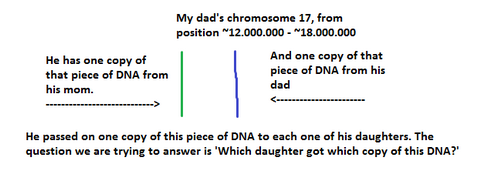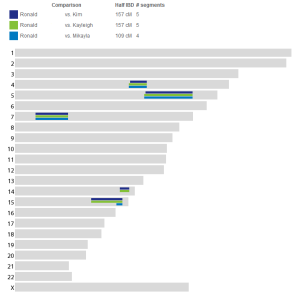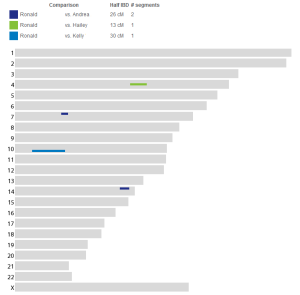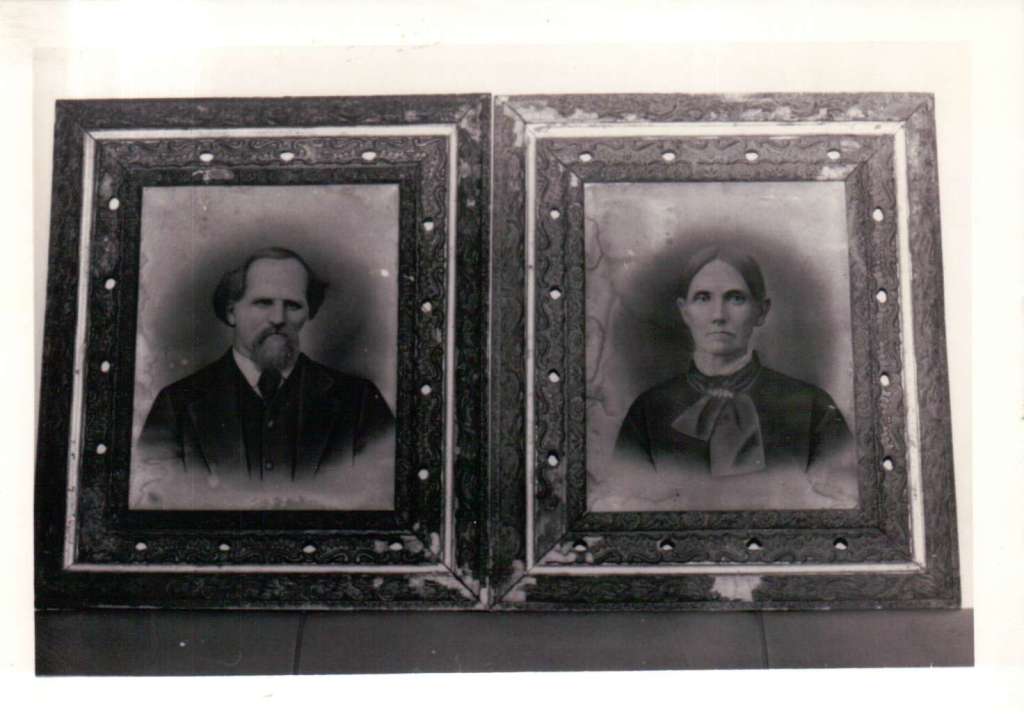Getting your close family members tested is immensely useful when trying to sort out your Relative Finder matches. Close relatives share some of your DNA, and they will also share some of your relatives.
It’s very straightforward when a family member shares the same relative in common as you do, like this.
In this case, my paternal first cousin shares the same segment with the same relative as I do. This provides clear evidence that this relative is related to me on my paternal side.
However, sometimes you can make a conclusion about which side a relative comes from even when a family member does not share the relative.
Let's say I want to try to figure out which side of my family this relative is on. Although I have lots of relatives tested, to keep things simple, I am going to pretend that the only person I have available to use is my paternal half-sister Kim.
The first step is to take note of the segment's location. This segment is on chromosome 2, and has a start point of 140.000.000 and an end point of 151.000.000.
The next step is to take a look at how I match my half-sister at that spot on chromosome 2 (this info is found using the 'View in a Table' feature in Family Inheritance: Advanced).
I need to check and see if Kim and I share DNA at the same spot as my 5th cousin and I do. And we do -- Kim and I have a shared segment that goes from position 129.000.000 to 181.000.000, which definitely encapsulates the segment that I share with my 5th cousin (140.000.000-151.000.000). This means that I can make a conclusion about which side of my family this match comes from. (Please note that if Kim and I did not share a segment at the same spot that I match my relative, no conclusion could be made).

I need to check and see if Kim and I share DNA at the same spot as my 5th cousin and I do. And we do -- Kim and I have a shared segment that goes from position 129.000.000 to 181.000.000, which definitely encapsulates the segment that I share with my 5th cousin (140.000.000-151.000.000). This means that I can make a conclusion about which side of my family this match comes from. (Please note that if Kim and I did not share a segment at the same spot that I match my relative, no conclusion could be made).
I know that I have two copies of chromosome two, one from my mom, and one from my dad. Kim and I got the same chunk of DNA on chromosome 2 from my dad (I know this because Kim and I are related only through my dad and not my mom). Therefore, if Kim also shares this match with me, this relative is on my dad's side. This is not the case -- Kim does not share this relative with me. Therefore I know this relative is not on my dad's copy of chromosome 2. The only other possibility is that this relative is on my mom's copy of chromosome two, and therefore I know that this relative is related to me on my mom's side.
You can sort out which parent your Relative Finder match came from by using collateral relatives that are related to one of your parents but not the other. Close relatives in this category include half-siblings, aunts and uncles, and first cousins. Siblings do not work for this because they are related to both of your parents and all four of your grandparents, just like you are. Therefore any shared DNA and shared relatives that you have with your sibling could have originated with either parent.
You can sort out which grandparent your Relative Finder match came from by using collateral relatives that are related to only one of your grandparents. Close relatives in this category include half first cousins or first cousins once removed, second cousins, great-aunts and great-uncles, and a variety of other relatives.
If you have a more distant relative tested, like a first cousin twice removed or something like that, it's possible to narrow down which great-grandparent a match comes from, and so on.
Also, if you have direct ancestors tested, the process is very similar to what I outlined above and in fact in some cases it's a little simpler. If you've got one of your parents tested, let's say your mom, and your Relative Finder match does not match your mom, you can reasonably conclude that the relative is on your dad's side. If you have a grandparent tested, and the Relative Finder match is not shared with your grandparent, you would follow the same checking-the-segments procedure that I outlined with Kim.
This method isn't perfect -- it's possible to have a 'false positive' match -- this means that your Relative Finder match does not match either one of your parents. It's also possible that a testing error, such as a miscall, will prevent a legitimate relative from properly showing a shared segment. But for the most part, comparing the segments like I outlined above should work for you. The larger the segment, the more accurate using this method is.
------------------------------------------------------------------------------------
You can also use the knowledge that you get ONE chromosome from mom and ONE chromosome from dad to your advantage when trying to sort out your relatives. What this means is that at any given spot in the genome, you share DNA with one and only one of your maternal ancestors and one and only one of your paternal ancestors.
If I share DNA with, let's say, my grandfather Ernest Badger, at a certain spot in the genome, I know for sure that I do not share DNA with my grandmother Audra Woodward at that same spot.
Graphically illustrated, this is what it looks like. At any given location, you can share DNA with one paternal grandparent or the other, but not both. You can share DNA with one maternal grandparent or the other, but not both.
Let's take a look at an example Relative Finder match. Andrea, Kim, Kelly, and Hailey are the four daughters of my dad. Aletha is our paternal aunt and Leona is our paternal first cousin once removed. Using the tools I've outlined above, let's see what we can find out regarding the side of our family that these relatives come from.

I told you earlier that aunts can sort out which parent a match comes from, and first cousins once removed can sort out which grandparent. So we know that our match 'Jack' comes from our dad's side, and our match 'David' comes from our paternal grandfather's side (because Leona is related only to our paternal grandfather, and not our paternal grandmother).
We don't have to stop here, though. By using the 'ONE piece of DNA = ONE ancestor' rule and by visualizing the chromosomes, we can make another conclusion -- we can decide which grandparent our match Jack comes from.
Now let's look back at our Relative Finder matches. Andrea, Kim, and Kelly all have the same relative and therefore the same piece of DNA. Hailey has the same relative and therefore the same chunk of DNA as our paternal first cousin once removed, and this cousin is related only to our paternal grandfather, my dad's dad. Therefore, Hailey got the 'blue' piece of DNA.
So here's what we have so far.
1. Every child inherited a piece of that DNA from dad.
2. Andrea, Kim, and Kelly inherited one piece, and Hailey inherited the other piece.
3. Hailey inherited the blue piece.
This leads us to our conclusion -- Andrea, Kim, and Kelly inherited the 'green' piece of DNA, the piece from my dad's mom (our paternal grandmother). We can now conclude that our Relative Finder match 'Jack' is related to us on our paternal grandmother's side.
I hope this mini-tutorial was not too hard to understand! The number of Relative Finder matches you are able to sort and the types of conclusions you are able to make will vary depending on which family members you have tested on 23andMe. If you have any questions, need any clarification, or want me to look at a specific situation in your family, please leave a comment or email me at


















